NorthEast Radio Watch 12/23 & 12/30/2024: WKIT Lives!
In this week’s issue… WKIT finds a buyer - Eskin out at WIP - Staff shifts in Utica - CRTC approves Bell divestitures
Text and photos by SCOTT FYBUSH
It’s hard to believe that it’s now been over 30 years since I began visiting beautiful Fort Wayne, Indiana – yet the city of my in-laws continues to offer new things to see each time we’re there.
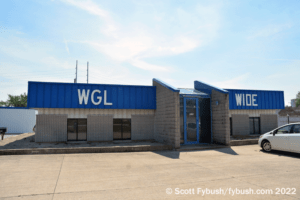

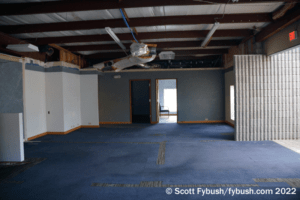

A stop this past summer didn’t include a lot of time for station visits, but fear not: we had to at least see the newest combined facility in town, a story which begins with rather a lot of complex history that takes us back to the earliest days of Fort Wayne radio.
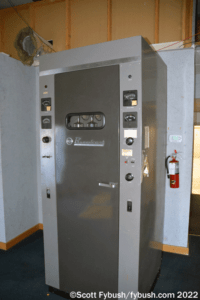

Even before there was WOWO, Chester W. Keen was first on the air in town, back in 1924, with WCWK. By 1928, WCWK was co-owned with WOWO, changing its callsign to WGL, and in 1936 Westinghouse bought both stations.
The end of radio duopoly in 1945 sent WGL off to Philo T. Farnsworth, the famed television inventor who’d recently relocated to Fort Wayne; later, WGL went to the local News-Sentinel, then through several other owners before ending up with Adams Radio Group.
In 1947, WGL moved from 1450 to 1250, erecting a new directional array south of the city on Lower Huntington Road; that move in turn opened up 1450 for a new radio station, WANE, which hit the air the next fall from a downtown office building rooftop.
WANE spawned a new TV sister station in the 1950s, today’s WANE-TV 15, and in 1966 the radio station was sold to new owners who renamed it WLYV, installed a screaming top-40 format, and moved the transmitter site from downtown to a small piece of land adjacent to a railroad roundhouse east of downtown.
In later years, 1450 went through a dizzying succession of owners and formats, playing country as WAFX and standards as WEZR, returning to WLYV with oldies, being sold to a succession of religious broadcasters, then ending up in Adams’ hands. That made it a sister station to WGL, based out of the longtime WGL transmitter facility on Lower Huntington Road, which had been expanded in the 1970s to house studios and offices as well.
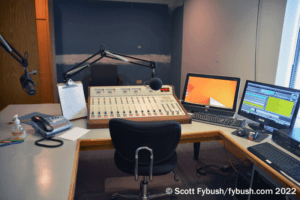

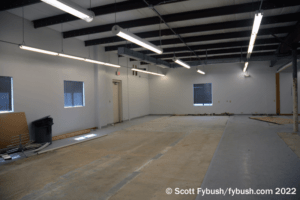

In 2019, Adams sold WLYV to Brian Walsh, who’d put oldies on the air in the area on WIOE-FM (101.1 South Whitley). Walsh flipped 1450 to WIOE(AM), simulcasting the FM oldies, adding a translator at 104.3 and eventually also simulcasting a morning show with WKSD (99.7) across the Ohio line, where veteran Fort Wayne jock Chris Roberts is both the owner and morning host.
And then COVID hit, which led Adams to shut down WGL (then with a sports format) at the end of March 2020. Walsh bought that station, too – but with only a short-term lease to keep it at the tower site adjacent to the Lower Huntington Road studios, where Adams’ FM stations remain.
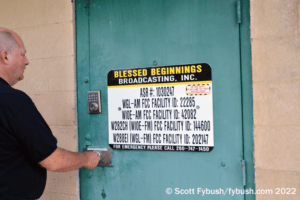

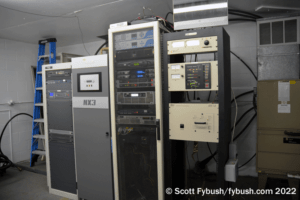

Did you guess that Adams was ready to sell off the land under the longtime WGL site next to the studio building? That is, of course, what happened – but Walsh had a plan B, relocating WGL to the WIOE tower site in the East Central neighborhood.
Before heading over to that site, we made a quick stop across town to see Brian’s work in progress, a repurposed office/storage building at West State Boulevard and Cass Street that’s becoming the studio and office home for WGL and WIOE. There’s a big front lobby where he’s parked the old RCA transmitter from WGL for display, a small studio where WIOE can originate its oldies format in the afternoon and on weekends when veteran WLYV jock Rick Hughes relives the good old days, and a big back room that will someday be offices.
(WGL doesn’t need a studio these days – in the morning it carries the Bob & Tom Show from Indianapolis, and the rest of the day it simulcasts the CBSN all-news channel from streaming TV.)
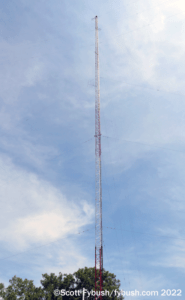

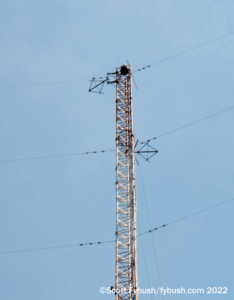

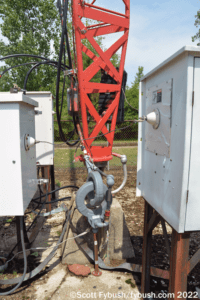

Over at the transmitter, there’s a lot more going on now than there was for the half century when the only thing emanating from this tower was the AM 1450 signal. Making two AMs and two translators work here requires filters and combiners to keep each station’s signal from getting into the other’s transmitter – and then there are three isocouplers at the base, one for each FM translator (104.3 for WIOE, 105.5 for WGL) and one for the FM receive antenna that picks up the WIOE-FM signal.
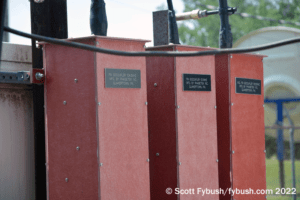

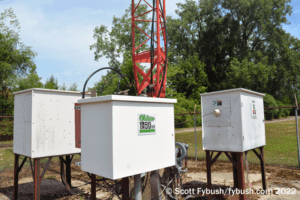

Inside the blocky transmitter building, there’s a lot going on, too. Walsh experimented with all-digital AM for several months on WIOE, only to realize that there was an audience in town that still wanted analog audio on 1450, which now broadcasts in C-QUAM stereo from its older BE transmitter, leaving the new Nautel idle. There’s a Gates Air transmitter for WGL, which currently operates under STA with 580 watts day, 250 watts at night, a quarter of its previous licensed power of 2500 watts day/1000 watts night – and of course the translator transmitters as well, feeding antennas at the top of the AM tower.
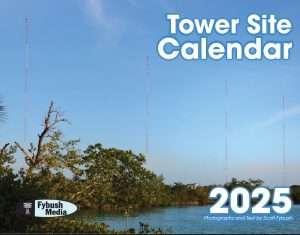
Behold, the 2025 calendar!
We chose the 100,000-watt transmitter of the Voice Of America in Marathon, right in the heart of the Florida Keys. This picture has everything we like in our covers — blue skies, greenery, water, and of course, towers! The history behind this site is a draw, too.
Other months feature some of our favorite images from years past, including some Canadian stations and several stations celebrating their centennials (can you guess? you don’t have to if you buy the calendar!).
We will ship daily through Christmas Eve. Place your order now for immediate shipping!
This will be the 24th edition of the world-famous Tower Site Calendar, and your support will determine whether it will be the final edition.
It’s been a complicated few years here, and as we finish up production of the new edition, we’re considering the future of this staple of radio walls everywhere as we evaluate our workload going forward.
The proceeds from the calendar help sustain the reporting that we do on the broadcast industry here at Fybush Media, so your purchases matter a lot to us here – and if that matters to you, now’s the time to show that support with an order of the new Tower Site Calendar. (And we have the new Broadcast Historian’s Calendar for 2025 ready to ship, too. Why not order both?)
Visit the Fybush Media Store and place your order now for the next calendar, get a great discount on previous calendars, and check out our selection of books and videos, too!
Thanks to Brian Walsh for the tour!
And don’t miss a big batch of Fort Wayne IDs next Wednesday, over at our sister site, TopHour.com!
Next week: Coming Down!
In this week’s issue… WKIT finds a buyer - Eskin out at WIP - Staff shifts in Utica - CRTC approves Bell divestitures
In this week’s issue… WBUR backs off local talk - EMF's expansion in NY, nationally - Rochester broadcasters honored - Russell finds new PA radio home - Remembering Bruce Stevens - The new calendar's here!
In this week’s issue… Remembering WNY's Palvino, Harris - Will King sell Bangor stations? - Kay moves earlier - New signal on LI - Cumulus cuts hit PA, New England - Frizzell sells in NH
In this week’s issue… Saluting a small-town radio vet - Bell moves CP24 - Scott heads west - Burlington gets Air 1, "Experimental Radio" - Family Life heads down I-86